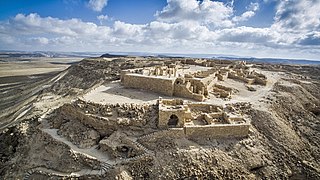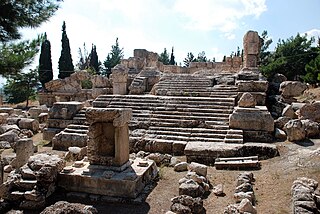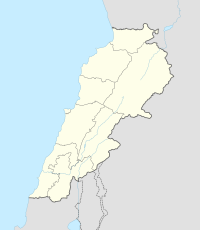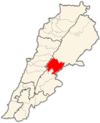
Byblos, also known as Jebeil, Jbeil or Jubayl, is an ancient city in the Keserwan-Jbeil Governorate of Lebanon. The area is believed to have been first settled between 8800 and 7000 BC and continuously inhabited since 5000 BC. During its history, Byblos was part of numerous cultures including Egyptian, Phoenician, Assyrian, Persian, Hellenistic, Roman, Genoese, Mamluk and Ottoman. Urbanisation is thought to have begun during the third millennium BC and it developed into a city making it one of the oldest cities in the world, if not the oldest. It is a UNESCO World Heritage Site.
An archaeological culture is a recurring assemblage of types of artifacts, buildings and monuments from a specific period and region that may constitute the material culture remains of a particular past human society. The connection between these types is an empirical observation. Their interpretation in terms of ethnic or political groups is based on archaeologists' understanding. However, this is often subject to long-unresolved debates. The concept of the archaeological culture is fundamental to culture-historical archaeology.

Paestum was a major ancient Greek city on the coast of the Tyrrhenian Sea, in Magna Graecia. The ruins of Paestum are famous for their three ancient Greek temples in the Doric order dating from about 550 to 450 BC that are in an excellent state of preservation. The city walls and amphitheatre are largely intact, and the bottom of the walls of many other structures remain, as well as paved roads. The site is open to the public, and there is a modern national museum within it, which also contains the finds from the associated Greek site of Foce del Sele.

Avdat or Ovdat, and Abdah or Abde, are the modern names of an archaeological site corresponding to the ancient Nabataean, Roman and Byzantine settlement of Oboda or Eboda in the Negev desert in southern Israel. It was inhabited with intermissions between the 3rd century BCE and the mid-7th century CE by Nabataeans, in their time becoming the most important city on the Incense Route after Petra, then by Roman army veterans, and Byzantines, surviving only for a few years into the Early Muslim period. Avdat was a seasonal camping ground for Nabataean caravans travelling along the early Petra–Gaza road in the 3rd – late 2nd century BCE. The city's original name was changed in honor of Nabataean King Obodas I, who, according to tradition, was revered as a deity and was buried there.

The Beqaa Valley is a fertile valley in eastern Lebanon and its most important farming region. Industry, especially the country's agricultural industry, also flourishes in Beqaa. The region broadly corresponds to the Coele-Syria of classical antiquity.

The Swedish Cyprus Expedition was assembled to systematically investigate Cyprus’s early archaeological history. The expedition occurred between September 1927 and March 1931 and was led by the three archaeologists Einar Gjerstad, Erik Sjöqvist and Alfred Westholm together with the architect John Lindros who photographed during their time in Cyprus. The excavation constitutes the foundation of modern archaeology in Cyprus. The results of the excavations revealed that the distinctive culture of early Cyprus had been created in close contact with various cultures from the Middle East and the western Mediterranean areas.

Niha is a village in the Bekaa Valley about 18 km (5.0 mi) north of Zahlé. It is famous for its Roman archeological ruins in the outskirts, and in particular two lower Roman temples that date back to the 1st century AD.

Tas-Silġ is a rounded hilltop on the south-east coast of the island of Malta, overlooking Marsaxlokk Bay, and close to the town of Żejtun. Tas-Silġ is a major multi-period sanctuary site with archaeological remains covering 4,000 years, from the neolithic to the ninth century AD. The site includes a megalithic temple complex dating from the early third millennium BC, to a Phoenician and Punic sanctuary dedicated to the goddess Astarte. During the Roman era, the site became an international religious complex dedicated to the goddess Juno, helped by its location along major maritime trading routes, with the site being mentioned by first-century BC orator Cicero.

Archaeology of Lebanon includes thousands of years of history ranging from Lower Palaeolithic, Phoenician, Roman, Arab, Ottoman, and Crusades periods.

The Temples of Mount Hermon are around thirty Roman shrines and Roman temples that are dispersed around the slopes of Mount Hermon in Lebanon, Israel and Syria. A few temples are built on former buildings of the Phoenician & Hellenistic era, but nearly all are considered to be of Roman construction and were largely abandoned during the persecution of pagans in the late Roman Empire.
Qal'at Bustra or Qalat Bustra is an archaeological site in Lebanon, close to the border of the Sheba Farms region of the Israeli-occupied Golan Heights, about 5 km ENE of Ghajar. It is situated on a peak of height 786m with a panoramic westward view. Qal'at Bustr is believed to be an ancient Roman sanctuary and was excavated by Israeli archaeologists. Remains found at the site include a farmhouse and temple dating from the Hellenistic and Roman period.

The Temples of the Beqaa Valley are a number of shrines and Roman temples that are dispersed around the Beqaa Valley in Lebanon. The most important and famous are those in Roman Heliopolis. A few temples are built on former buildings of the Phoenician & Hellenistic era, but all are considered to be of Roman construction and were started to be abandoned after the fourth century with the fall of the Roman Paganism.
Gabal El Haridi is an archaeological site in Egypt approximately 350 kilometers south of Cairo within Sakulta, in Sohag Governorate in Upper Egypt. The site is located south of Qaw El Kebir (Tjebu), in an area between the towns of El Nawawra and El Gelawiya. The site is very important historically because of the Coptic presence throughout the site. This is because this was the beginning of the use of isolated monasteries that brought the hermits together in a settled community. Significant unknown writings from the Ptolemaic period were found and recorded. The extensive quarrying throughout time suggests that Gabal El Haridi contained one of the more important sources of stone under the Ptolemies and Ramses III. The looting and destruction of the site has caused the site archaeologists great difficulty in determining specific details such as dates and owners of tombs. The details that have been obtained have allowed for a greater understanding of the changes in use of the site throughout its occupation for three thousand years.

Qasr el Banat is an ancient temple situated 1.5 kilometres (0.93 mi) east of Chlifa in the Baalbek District of the Beqaa Governorate in the city of Qsarnaba (Lebanon).

Qalaat Faqra is an archaeological site in Kfardebian, Lebanon, with Roman and Byzantine ruins. Located near the Faqra ski resort on the slopes of Mount Sannine at an altitude of 1500 m, it is one of the most important sites of the UNESCO-listed valley of Nahr al-Kalb.
The archaeological site of Al-Ashoosh is a third-millennium BC settlement located 70 km (43 mi) south of Dubai in the United Arab Emirates (UAE). It is an important example of inland desert occupation in the period following the Holocene Climatic Optimum period and of human occupation in the Rub' al Khali during the Umm Al Nar period. Archaeologists believe Al-Ashoosh was a seasonal settlement occupied by a hunter/pastoral community, probably occupying structures of perishable materials, during the second half of the third millennium BC. It is thought the water table would have been higher, supporting inland settlement in what is now a plain and arid site with a brackish well. The site was used for the production of stone tools.
Ruth Lorraine Young FHEA is Professor of Archaeology at the University of Leicester.
The archaeology of ancient Egypt is the study of the archaeology of Egypt, stretching from prehistory through three millennia of documented history. Egyptian archaeology is one of the branches of Egyptology.

Augusti Pagus was a Roman settlement in Roman Phoenicia. It was created in the 110s AD and lasted nearly seven centuries until the Arab invasion of the Levant. The settlement was named in honor of Roman Emperor Augustus, who ordered the development of this pagus in the central-northern hills of the Beqaa Valley.

















